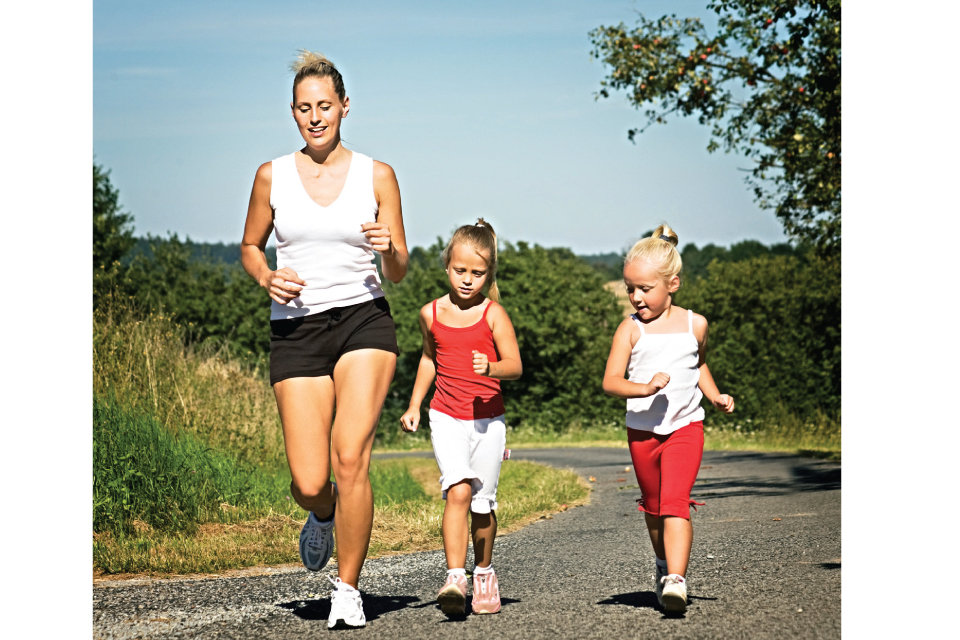Running: Family Style

Austin is the running mecca of the Southwest, if not the entire United States. Our local running culture touches all walks of life, from our children to our seniors. Many in our country, however, are battling a modern lifestyle of effortless transportation and air conditioning. Americans simply don't spend enough time moving and sweating, leaving us with high stress, excess weight, too many easy calories, and a busy lifestyle that fosters the perception of no time to exercise. The secret to overcoming this and becoming an active, healthy America is for you and your family to become endurance athletes—to become runners.
Before we get “into the weeds” on the subject of running, I want to describe the spectrum of forward motion that comprises endurance athletics. Forward motion includes walking, jogging, running, and culminates with sprinting. Each movement within the spectrum has its own biomechanical requirements as well as specific benefits.
Running has many elements that are appropriate for all ages and abilities, and how one approaches running is very important. Training should be strategic and progressive. Runners must first build strength in their muscles, tendons, and bones. Their cardiovascular systems must develop before they can extend distance. Because of this common need to build balance and base, it’s possible to include families in endurance training. Beginners can start together, working to build the necessary physical base for success. If you’re a seasoned athlete, you should be able to reach back in your run training to include your family on your lighter or cross training days and to even act as their coach.
While many of us running in Austin have a routine that involves stepping out of the car at Lady Bird Lake and running one of the three, four, five, seven, or ten-mile loops three to four days a week, there is so much more runners can be doing. Your body must maintain or build "spring" into your stride, and this type of training is easily done with your children, your spouse, and even your parents. To build spring into your stride, finish your distance runs with a few strides ranging from 50- to 100-yards. Run at a moderate pace to start and pick up speed as you go. Avoid sprinting; simply open up, moving from a jogging stride to a running stride.
Here’s a weekly workout that can be done together, is very simple, and can use the track, a hill, a park, or a street. Start with an easy half-mile to one-mile warmup. Follow with drills: side-to-sides, over-unders (also called “grapevines”), backwards running, skips, high knees, and fluid strides. Repeat each drill, over 50 – 100 yards (one repetition includes down and back). End with a 1-2 mile cool down. Try to finish with a pull-up set or (if you can’t do a pull up) hang from a bar to lengthen and strengthen the core and back. This workout is beneficial to all endurance athletes, no matter the age or fitness level.
Running, a very efficient form of exercise, requires a lot of preparatory training and maintenance work. Most runners log too many miles in relation to the time they spend on quality workouts and cross training. Conditioning is one vital element of training that can easily be a shared experience, with no one left behind or overly stressed by an exercise that is too difficult. Cross training needs to be part of your strategy before you start running, while you are running, and when you are in an off season or in recovery after a major event. Unlike run training (which has to be very strategic to ensure that the right paces, intervals, and distances are achieved), cross training is more inclusive. These non-running activities are a great way for families to train together and for runners to benefit from the workouts. Drills, weights, CrossFit, Pilates, and yoga can be easily adjusted to each generation.
No matter your age, it is critical to consider yourself an athlete with a plan and surround yourself with the right team. Children, parents, and grandparents all need to be engaged in goal-orientated training. Some elements of athletic success include having a coach, being on a team, owning proper gear and training for a meaningful event. Diet and exercise alone can leave you living a life of frustration and scarcity, while being an athlete can bring you to a life of abundance, confidence, and success.
There is no age or stage of life that can't enjoy the thrill of victory.
Paul Carrozza is a former All-American runner from Abilene Christian University. In 1988, he founded RunTex, which became the nation’s largest retail store solely devoted to running. Carrozza also founded RunTex U (a training division of RunTex) and RunTex Events (which produces over 120 events per year and raises over $5 million annually for local charities). He is also the co-founder and sponsor of RunTex Marathon Kids, a program that introduces elementary school children to the joy and benefits of running. Since 1997, Carrozza has been the Footwear Editor of Runner’s World Magazine, and he currently serves on many boards and committees, including the Texas Department of Aging, the Governor’s Fitness Council, the Mayor’s Fitness Council, and the President’s Council on Physical Fitness and Sports.






